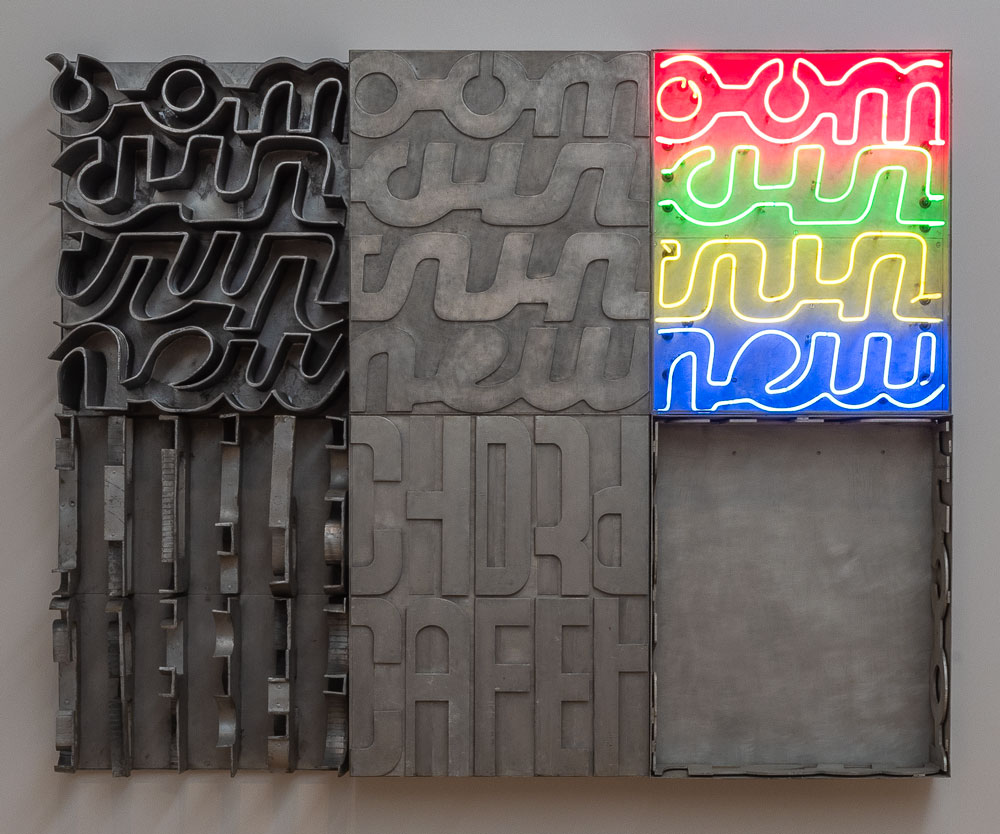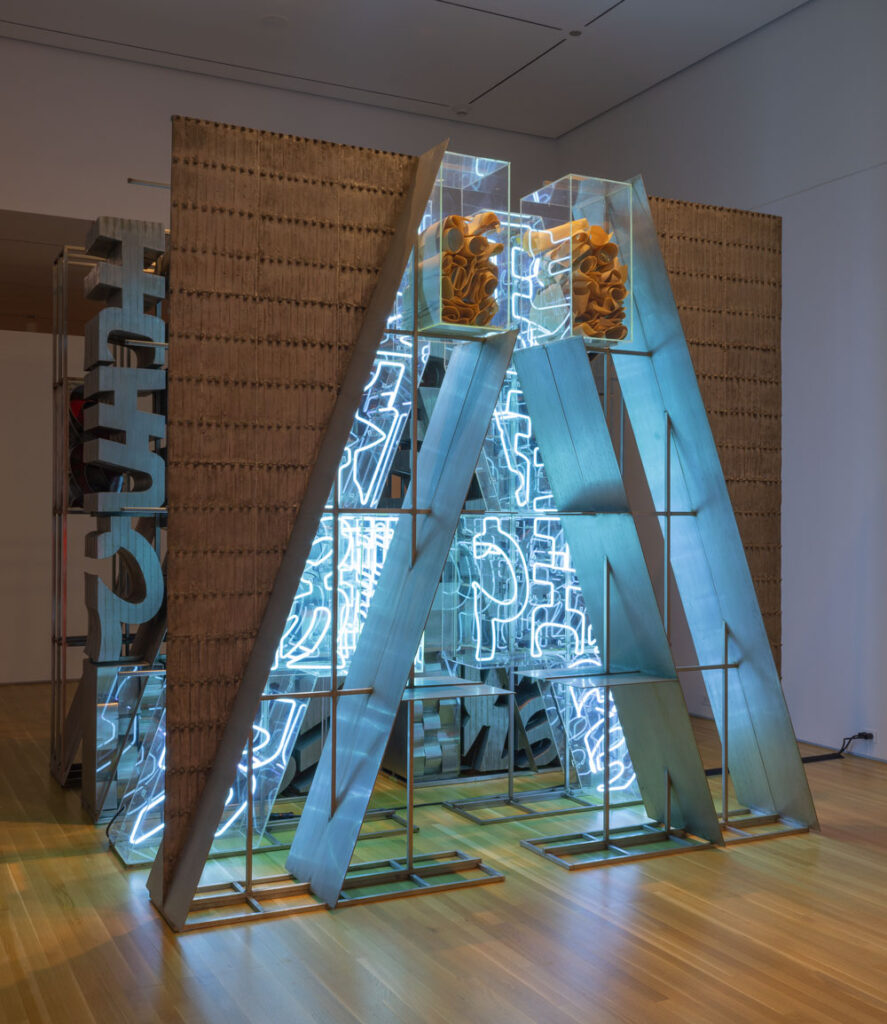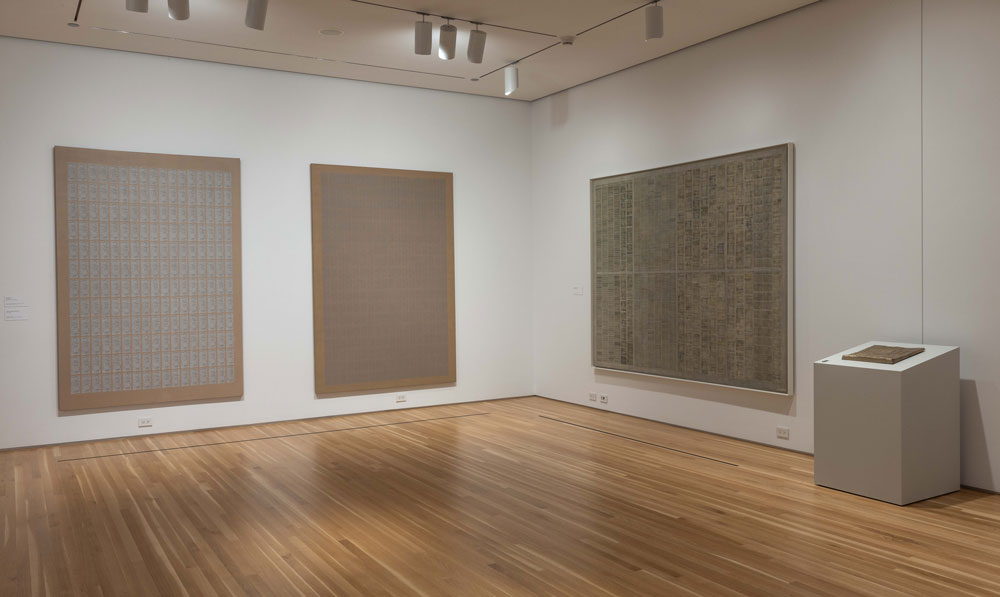
For full impact, viewing art will always be a “live, up-close and personal” kind of activity. Pictures just don’t offer the benefit of scale and dimension to permit wholesale appreciation of the images and objects artists create. Not to mention their limitations in translating attributes that take in the tactile like texture and finish. Without that knowledge, you’re left with mere facsimiles.
For all of those reasons, facsimile is exactly what you want to avoid when considering Wrightwood 659’s newest exhibition, Chryssa and New York. Because of the materials used, the color palettes employed, the subtleties of technique and, most importantly, the power they exude in real time, the works in this show by a groundbreaking Greek born artist requires your presence to fully reveal their unparalleled charms.
In the 1960s and 70s, Chryssa Vardea-Mavromichali, who professionally simply went by Chryssa, captivated the art world with her pioneering work with neon and light. As a young aspiring artist arriving in New York in the 50s from a country still emerging from the gray devastation of war, she was smitten by the bombastic dazzle of Times Square. Marshalled to drive a commercial message, something about its brightness, brashness and color sparked a fascination and then a passion. Her mind conceived of other uses for the bold extravagance of the medium that went beyond drawing attention to a product or stimulating a craving. There was something about its allure that she found enthralling and wanted to explore.

Frequently using discarded materials, she fashioned sculptural designs that incorporated light, metal and often both together to make commentary about her adopted country and her responses to it. But inspiration could come from many sources; including the idle observations we notice in nature. Using neon lighting in cool blue with four identically shaped tubes suspended one on top of the other, she simulated birds taking off in flight by having the tubes light in six second intervals from bottom to top. Ascribing your own interpretation to what you see in the work isn’t discouraged. Other pieces may be more visually arresting, but they all share a hint of mystery that skirts on suspense.
Housed in plexiglass, bright red neon tubing fills a case in a congestion of angles and swirls. Luminous and hypnotic, you eventually see the letters U S A emerge from the tangle of color. In AUTOMAT, fourteen letters fill a frame. Half glow in multi-colored neon and half appear simply as raised letters, the same color and texture of their mat. Scattered randomly as if on a gameboard, you don’t immediately notice that both sets of letters spell out the same word. A sophisticated take on clever and amusing, AUTOMAT places whimsy and contemplative scrutiny on the same footing.

At the time it was creating such a sensation on the art scene, Chryssa’s work was also easily eluding categorization. There were obvious abstract and minimalist influences, but it remained distinct from both forms. Aspects of what she was doing hinted at the Pop scene that would blossom in the 70s with the advent of Warhol, but it is was more a precursor to that world than a part of it. What’s considered her supreme achievement, The Gates of Times Square, completed between 1964 and 1966 stands alone as its own idiom. Included in the exhibition, the first comprehensive celebration of her work in North America since 1982, the imposing 10-foot square block of light and metal stands as much a wonder of creation as it does a work of art. The gallery’s low lights intensify its seduction and mystery. In satiny blue light and filled with abstract designs in the same neon color, a massive bisected capital letter A acts as the gates narrow entrance. As contemporary and polished as The Gates to Times Square appears, there’s a quality that rises from it that drips with antiquity. It’s so solemn and quietly centered. As you walk around the piece and take in how intricately it’s formed, the scale of creative and technical investment needed to complete something so resolutely astonishing begins to come clear. Each requiring skilled customized fabrication, the large metal pieces filling the body of the work look like characters from an ancient and unknown language. Their inscrutability adds to the work’s beauty and perhaps, more crucially, to the power it radiates like fine smoldering heat.

Gratefully, Chryssa and New York also includes her Newspapers series where the artist turns her eye to mass communication, printed media and language. Once again salvaging discarded materials, this time cast off printing plates used for advertising or stock exchange tallies, she completely transforms them into objects of both curiosity and profound beauty. The process requires the plates to be repeatedly and meticulously stamped onto a surface, eventually covering it in uniform grids of text. As the works evolve, the text become less and less legible either because of their small size or because it’s intentionally obscured. Placed on surfaces that project grandeur, status or vaunted provenance, the text becomes glorified and given new meaning because its context has been elevated. The technique makes many of the pieces captivating simply for their impact and the gravitas they project.
In much of Chryssa’s work, she seems to distill and distill until she arrives at the essence she’s striving for. That’s particularly true of her Cycladic books on the top floor of the exhibition. Form and light combine to make up the basis of these works. Their name is taken from the Greek islands known as the Cyclades and the marble forms that were discovered there dating back from 2300 and 5200 B.C. Usually sleek, minimalist and vaguely abstract; the figurines, almost always of women, look startlingly modern. Bereft of lettering or true definitive form, the books extend the minimalist conceit to its outer limits and present it in marble, terra cotta and other materials. The approach is sublime and even challenging. But the way it effectively erases the line between the old and the new is irrefutable.
No clear reason has ever been given why Chryssa’s notoriety ebbed and virtually dissipated in the 80s and beyond. Gender and sexuality may have been factors. Some have accused her work as sometimes being difficult. Absorbing might be a more accurate description of its affect. It’s also singular, fascinating in concept and achieves the kind of beauty that defies time. All reasons why Chicagoans with a taste for the adventurously exceptional should relish this salute to an immigrant who contributed so much to the nation’s artistic legacy.
Chryssa and New York
Through July 27, 2024
Wrightwood 659
659 W. Wrightwood Street
Open Fridays and Saturdays only
Chicago, IL 60614